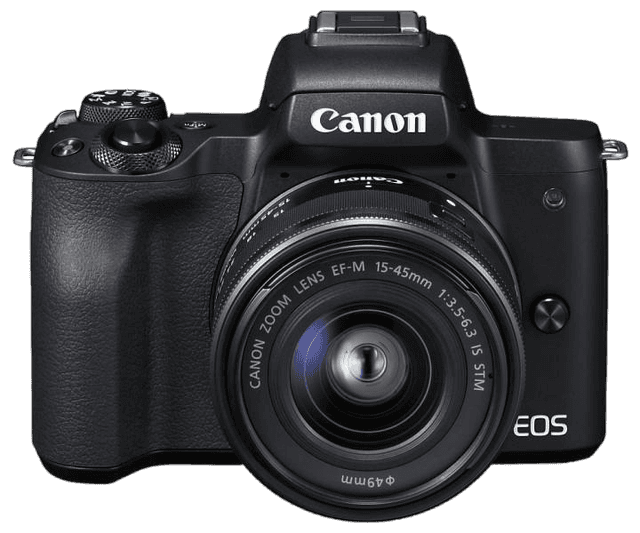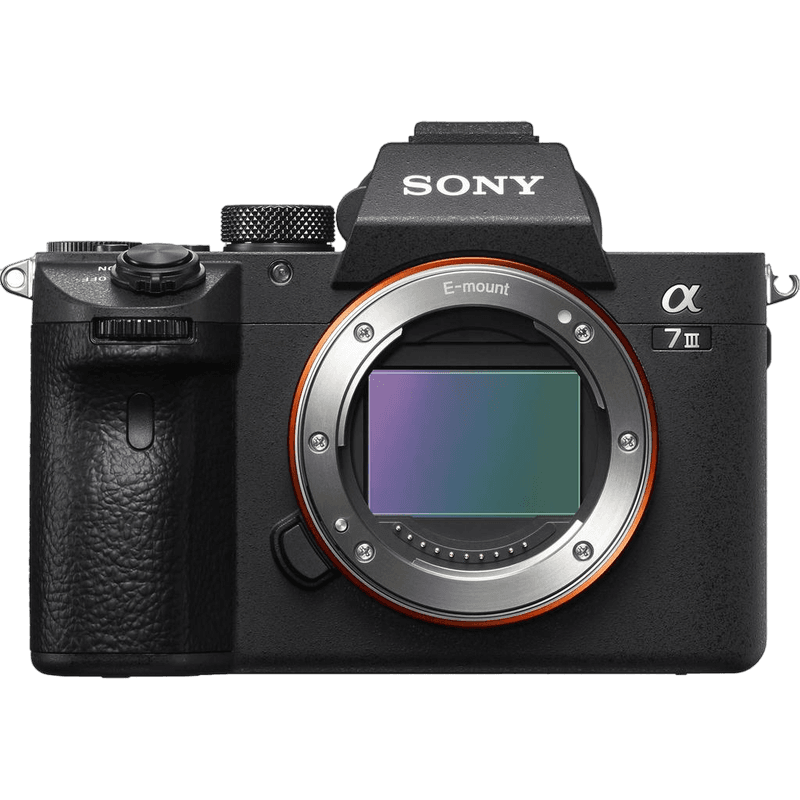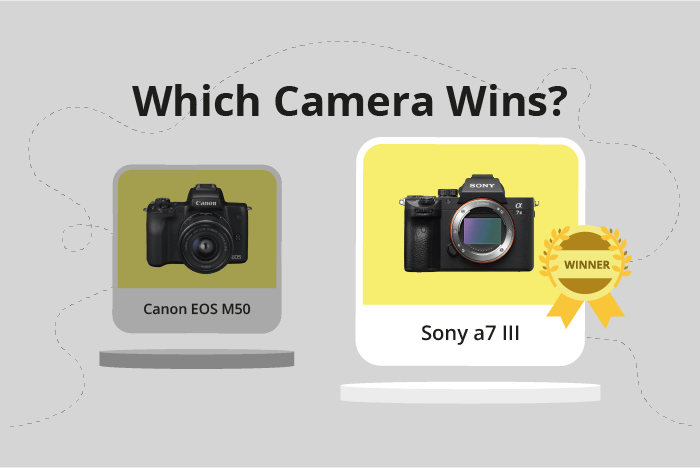Canon EOS M50 vs Sony a7 III Comparison
Canon EOS M50

Sony a7 III

The Sony a7 III outperforms the Canon EOS M50 with a score of 80/100 compared to 59/100. Both cameras are mirrorless and were released in 2018. They share similarities in general specifications, including announcement dates and camera type. However, the Sony a7 III excels with its higher score, which reflects its superior performance.
The Canon EOS M50 has a few advantages, such as a lower launch price of $779 and lighter weight at 390g. On the other hand, the Sony a7 III boasts a higher overall score, showcasing its better features and capabilities. Despite its higher launch price of $2000 and heavier weight at 650g, the Sony a7 III is the clear winner in this comparison.
Ultimately, the Sony a7 III’s higher score signifies its superior performance and features, making it the better choice for photographers seeking a top-quality mirrorless camera.
Canon EOS M50 vs Sony a7 III Overview and Optics
The Sony a7 III emerges as the winner in the optics comparison with a score of 81/100, outperforming the Canon EOS M50, which scored 59/100. Both cameras share some common specifications, such as 24-megapixel resolution, 10 fps shooting speed, and a CMOS sensor type. However, the Sony a7 III excels in certain aspects, making it the superior choice in terms of optics.
The Sony a7 III boasts a full-frame sensor, while the Canon EOS M50 has an APS-C sensor. This difference contributes to the Sony a7 III’s higher DXOMARK score of 96, compared to the Canon EOS M50’s score of 58. The full-frame sensor in the Sony a7 III allows for better low-light performance and a shallower depth of field. Additionally, the Sony a7 III has image stabilization, which the Canon EOS M50 lacks, further enhancing its image quality and versatility.
The Canon EOS M50, on the other hand, features a Digic 8 processor and Canon EF-M lens mount. While these aspects may not be enough to surpass the Sony a7 III in terms of optics, they still contribute to the camera’s overall performance and compatibility with Canon lenses.
In the optics comparison, the Sony a7 III stands out as the clear winner, offering a full-frame sensor, higher DXOMARK score, and image stabilization. The Canon EOS M50, while not as strong in the optics department, maintains its value through its processor and lens mount compatibility. Ultimately, the choice between these two cameras depends on one’s specific needs and preferences, but the Sony a7 III proves to be the superior option for optics.
Canon EOS M50 vs Sony a7 III Video Performance
The Canon EOS M50 outperforms the Sony a7 III in video capabilities, with a video score of 91/100 compared to Sony’s 56/100. Both cameras share common specifications, such as 4K max video resolution and max video dimensions of 3840 x 2160. However, the differences in their video features make the Canon EOS M50 a superior choice for videographers.
The Canon EOS M50 excels in its max video frame rate, offering 120fps, which is significantly higher than the Sony a7 III’s 30fps. This higher frame rate allows for smoother slow-motion footage and greater flexibility in post-production. Additionally, the Canon EOS M50 has built-in time-lapse functionality, making it more convenient for capturing creative and dynamic time-lapse videos.
While the Sony a7 III falls short in these aspects, it still provides high-quality 4K video resolution and is suitable for videographers who do not require higher frame rates or built-in time-lapse functionality. Despite its lower video score, the Sony a7 III remains a reliable option for those focused on still photography and not seeking advanced video features.
Considering the differences in video capabilities, the Canon EOS M50 is the better choice for those prioritizing video performance, offering a higher frame rate and built-in time-lapse functionality. The Sony a7 III, on the other hand, is suitable for photographers who do not require advanced video features but still want 4K video resolution.
Canon EOS M50 vs Sony a7 III Features and Benefits
The Sony a7 III outperforms the Canon EOS M50 in features, scoring 81/100 compared to the M50’s 70/100. Both cameras share some common specifications, such as a 3-inch screen, touchscreen functionality, flip screen, absence of GPS, and the presence of WIFI and Bluetooth connectivity.
The Sony a7 III surpasses the Canon EOS M50 in screen resolution, with 921,600 dots compared to the M50’s 1,040,000 dots. This higher resolution provides the a7 III with a clearer and sharper display, enhancing the user’s experience when composing and reviewing images.
Despite the higher feature score of the Sony a7 III, the Canon EOS M50 has its advantages. Its screen resolution is higher than the a7 III’s, providing a crisper and more detailed display for users. This can be particularly useful when reviewing images or videos on the camera’s screen.
In comparing the features of both cameras, it is evident that the Sony a7 III has an edge over the Canon EOS M50 due to its higher score. This is primarily due to the a7 III’s superior screen resolution. However, the M50 holds its own with a higher screen resolution, which can be an important factor for some users. Both cameras offer valuable features, and the choice between them may depend on the individual’s specific needs and preferences.
Canon EOS M50 vs Sony a7 III Storage and Battery
The Sony a7 III outperforms the Canon EOS M50 in storage and battery, scoring 68/100 compared to the M50’s 13/100. Both cameras accept SD, SDHC, and SDXC memory cards, but the a7 III has the advantage of two memory card slots and compatibility with Memory Stick Duo, Pro Duo, and Pro-HG Duo cards.
The a7 III’s superiority is further evident in its battery life, offering 750 shots per charge, while the M50 only provides 235 shots. Both cameras use different battery types, with the a7 III utilizing the NP-FZ100 and the M50 using the LP-E12. Neither camera supports USB charging.
Despite the M50’s shortcomings, it still offers a single memory card slot and a respectable battery life for casual photography. However, the Sony a7 III is the clear winner in terms of storage and battery capabilities, making it a more suitable choice for photographers who require extended shooting sessions and additional storage options.
Canon EOS M50 vs Sony a7 III – Our Verdict
Are you still undecided about which camera is right for you? Have a look at these popular comparisons that feature the Canon EOS M50 or the Sony a7 III:

